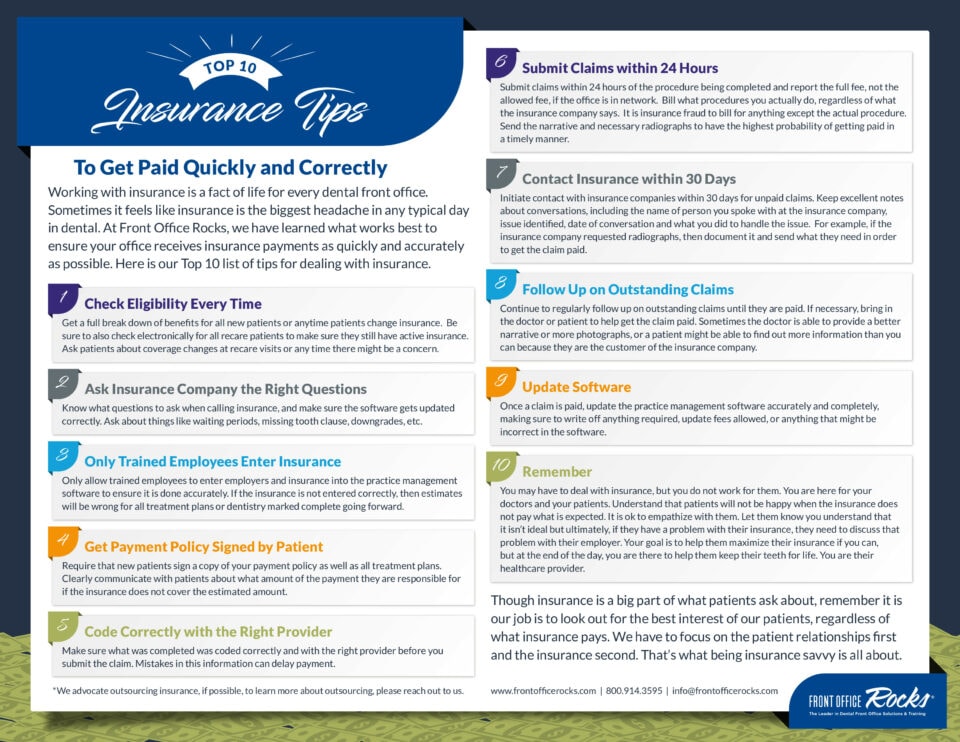The Best Approach for Multiple Insurance Plans
Sometimes a patient has two insurance plans. This can be a confusing situation. How do you know what you need to do to submit to both plans, and in which order?
When your patient has more than one plan, first determine if the plan has a coordination of benefits. In other words, if insurance company #1 pays toward treatment, will insurance company #2 also pay? If they do coordinate benefits, then you will submit to both. However, if this coordination does not exist with one of the insurance companies, then you can expect they will not pay out if treatment is covered by the other company.
If the insurance companies do allow for it, then the patient can receive the maximum allowable benefit, i.e. the maximum amount that each dental plan will pay. Now, address which company should receive the claim first. When both insurance plans allow for coordination of benefits, then prioritize (treat as primary) the plan in which the patient is enrolled as an employee or is named as the main policy holder. The plan that the patient is enrolled in as the dependent would then be their secondary insurance. In other words, if the patient has insurance with their own employer, then that insurance will be their primary. If the patient also has insurance through their spouse as a dependent, then that would be their secondary insurance.
Which policy pays first for dependents can be confusing, and many times it depends on the rules of the insurance policy or on the specifics of state law. Typically for dependents, when both plans will cover them, the plan of the parent whose birthday occurs first in a calendar year will be primary. Sometimes there are other considerations, such as which insurance has been in effect longer or the gender of the insured. In the case of divorce, then whatever is determined in the divorce agreement will determine which insurance is primary.
When dealing with dual insurance coverage, follow these suggestions for the best possible payment outcome:
- Be very careful what you estimate will be covered for the patient, because there are a lot of variables to take into account when working with two insurance companies.
- Submit the claim to the insurance carrier you believe to be primary first. Be sure to complete the section on the claim form about the other insurance coverage, regardless of whether you plan to submit to them for payment or not.
- Just like with any claim, it is best to submit your full fee on the claim and allow the insurance company to apply the relevant plan allowances or fee schedules.
- Always submit a copy of the primary EOB once you receive it with the secondary claim, as they will require it in order to pay the claim.
Dealing with two insurance policies can be complicated, but it is worth it. In some cases, your office will end up being paid more than if only one insurance had been involved. Keep in mind, however, that another reason to go through the potential headache of dual insurance is the patient has more than one kind of coverage, and ultimately, we are here to make it as easy as possible for patients to continue coming to us for a lifetime of good dental health.
In the end, dealing with two insurance plans can benefit your office and your patients.
Related Dental Training Resources:
- [Course Outline] Dental Financial Coordinator Training
- NEW! [Infographic] Top 10 Insurance Tips For Getting Paid Quickly and Correctly (Member access only)
- [Infographic] Why Your Office Should Consider a Membership Club (Member access only)
- [Article] Is Your Dental Office Insurance Driven, or Insurance Savvy? There’s a Big Difference
- [Article] Insurance Outsourcing: Is it right for your dental office?
- [Training Video] Top 5 Dental Insurance Questions Webinar with Laura Hatch and Teresa Duncan (Member access only)
New to Front Office Rocks and not yet a member?
Visit our dental training webinar replays and video clips available to the public here on Laura’s YouTube Channel!


